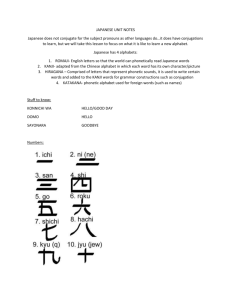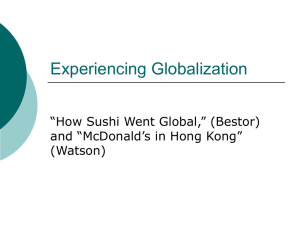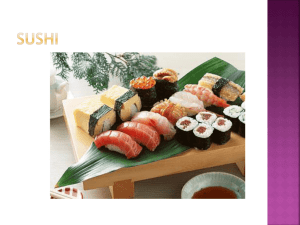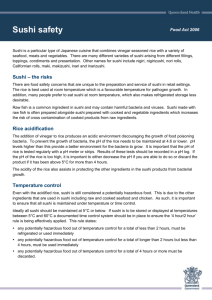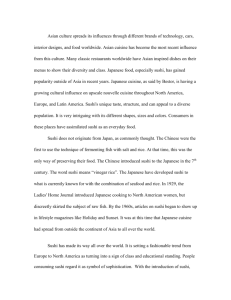The History of Sushi
advertisement
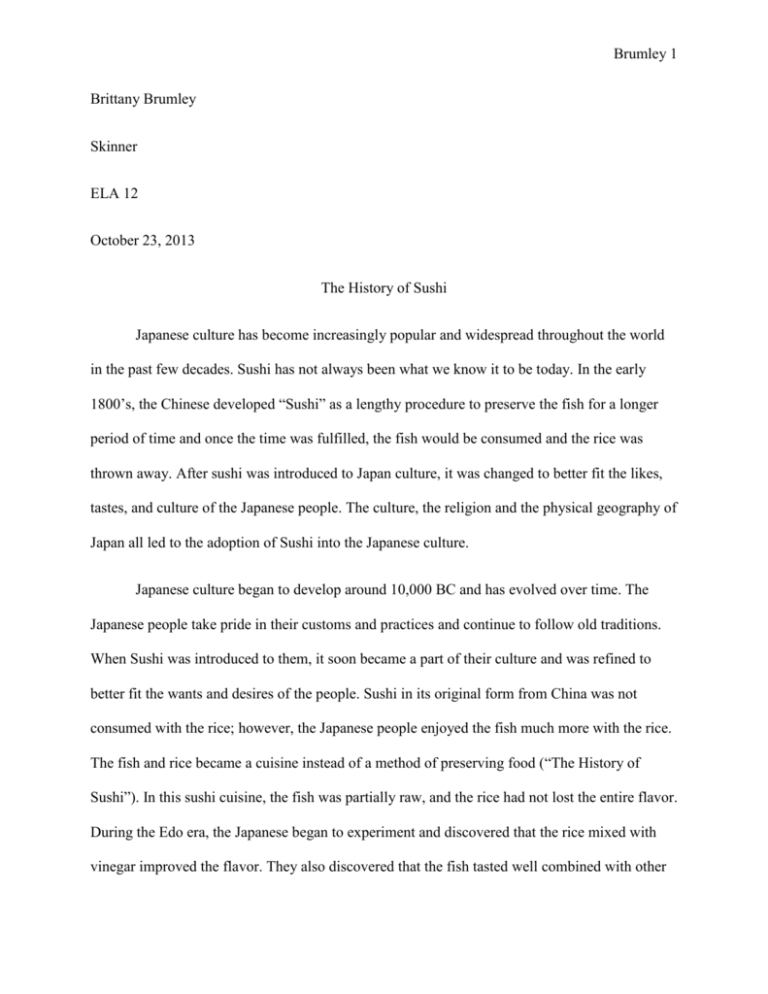
Brumley 1 Brittany Brumley Skinner ELA 12 October 23, 2013 The History of Sushi Japanese culture has become increasingly popular and widespread throughout the world in the past few decades. Sushi has not always been what we know it to be today. In the early 1800’s, the Chinese developed “Sushi” as a lengthy procedure to preserve the fish for a longer period of time and once the time was fulfilled, the fish would be consumed and the rice was thrown away. After sushi was introduced to Japan culture, it was changed to better fit the likes, tastes, and culture of the Japanese people. The culture, the religion and the physical geography of Japan all led to the adoption of Sushi into the Japanese culture. Japanese culture began to develop around 10,000 BC and has evolved over time. The Japanese people take pride in their customs and practices and continue to follow old traditions. When Sushi was introduced to them, it soon became a part of their culture and was refined to better fit the wants and desires of the people. Sushi in its original form from China was not consumed with the rice; however, the Japanese people enjoyed the fish much more with the rice. The fish and rice became a cuisine instead of a method of preserving food (“The History of Sushi”). In this sushi cuisine, the fish was partially raw, and the rice had not lost the entire flavor. During the Edo era, the Japanese began to experiment and discovered that the rice mixed with vinegar improved the flavor. They also discovered that the fish tasted well combined with other Brumley 2 vegetables and other dried foods. These changes led to the diverse, intricate and delicate art form of sushi today. Though it has spread around the world more since the 1900’s, the art form and importance of culture has been present all around. The cultures of Japan influenced sushi because without sushi having spread from China to Japan and becoming an important asset to their culture, the spread into other countries and parts of the world may have been ignored or not have happened. Religion played a big factor in the development of Japanese cuisine and dining preferences. Buddhism, the biggest and most popular religion of Japan, banned meats from being consumed. This then made fish one of the biggest sources of protein due to the surrounding oceans and availability of many species and amounts of fish (“Japanese Religion”). This allowed sushi to be an important cuisine to the daily lives of the Japanese people. Other religions were adopted as well, each being changed and adapting to better fit the Japanese culture. In Japan, sushi is most often consumed for a special occasion or celebration (“Sushi”). Religion shaped sushi because of the various religions and their beliefs. Meats were no longer “allowed” to be consumed, though hunters often consumed their catches, which allowed sushi to become more popular. The sushi provided the people with needed nutrition, especially protein. Rice and vegetables added flavor, making sushi very popular among the Japanese people and the people in other countries that were introduced to the sushi foods. The religions of Japan helped to better develop and expand the current knowledge of sushi and made it easier to experiment with many more flavor combinations due to the restrictions of other meats. The physical geography of Japan in the world influences the ability to make sushi often due to the availability of many types of fish. Japan is an island surrounded by the Japan Sea, Okhotsk Sea, and the Pacific Ocean. The availability of fish to the people was very abundant. As Brumley 3 long as there was the ability for fishers to safely fish in the ocean, there was a constant food supply of fish and sushi. According to UN Seahorse: Oceans around Japan, Japan is made up of over 1000 islands, which has over 34,390 kms of coastline. The three bodies of water surrounding Japan support thousands of species of fish. With this many species, there is large variety in the types of fish available to eat in sushi. The geography of Japan and Japan being islands surrounded by oceans helped influence the art form and sushi cuisines a great deal. Without this geography, sushi may never have developed to such an important cuisine in Japan and other parts of the world. The culture, the religion and the physical geography have each influenced sushi and allowed it to develop into the beautiful and tasty art form and cuisine that it has become today. These things each played a special role in the development and the popularity of sushi. It may not have been a great deal without these things-culture, religion and physical geographychanging sushi into such a special and respected food. Japan is very well known for their sushi and it has become a food that is very unique and tasty. Brumley 4 Works Cited "Japanese Religion." Japanese Religion Origins, Japanese Religion History, Japanese Religion Beliefs. Patheos, n.d. Web. 22 Oct. 2013. "Sushi." Sushi. Japan-Guide.com, n.d. Web. 23 Oct. 2013. "The History of SUSHI." The History of SUSHI. Tomoe Co., Ltd., n.d. Web. 22 Oct. 2013. "Things Japanese - "A History of Japanese Cuisine"" History of Japanese Cuisine. Yamasa Student Network-The Yamasa Institute, n.d. Web. 22 Oct. 2013. "UN Seahorse: Oceans around Japan." UN Seahorse: Oceans around Japan. UN Seahorse, n.d. Web. 22 Oct. 2013.
